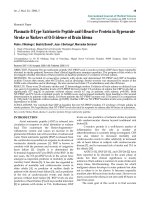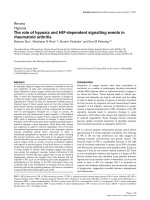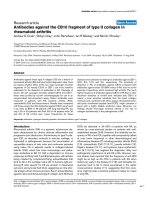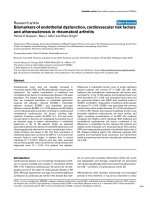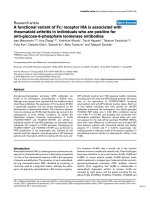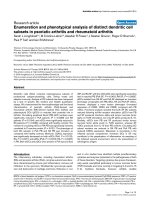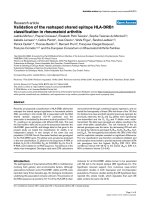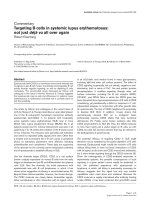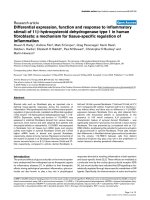Báo cáo y học: "Class-switched B cells display response to therapeutic B-cell depletion in rheumatoid arthritis" docx
Bạn đang xem bản rút gọn của tài liệu. Xem và tải ngay bản đầy đủ của tài liệu tại đây (655.74 KB, 11 trang )
Open Access
Available online />Page 1 of 11
(page number not for citation purposes)
Vol 11 No 3
Research article
Class-switched B cells display response to therapeutic B-cell
depletion in rheumatoid arthritis
Burkhard Möller
1
, Daniel Aeberli
1
, Stefan Eggli
2
, Martin Fuhrer
1
, Istvan Vajtai
3
, Esther Vögelin
4
,
Hans-Rudolf Ziswiler
1
, Clemens A Dahinden
5
and Peter M Villiger
1
1
Clinic for Rheumatology, Clinical Immunology, and Allergology, Inselspital – University Hospital of Bern, Freiburgstraße, Bern 3010, Switzerland
2
Department of Orthopaedic Surgery, Inselspital – University Hospital of Bern, Freiburgstraße, Bern 3010, Switzerland
3
Section of Neuropathology, Institute of Pathology, University of Bern, Murtenstraße 31, Bern 3010, Switzerland
4
Department of Orthopaedic, Plastic and Reconstructive and Hand Surgery, Inselspital – University Hospital of Bern, Freiburgstraße, Bern 3010,
Switzerland
5
Institute of Immunology, Inselspital – University Hospital of Bern, Freiburgstraße, Bern 3010, Switzerland
Corresponding author: Burkhard Möller,
Received: 28 Nov 2008 Revisions requested: 13 Jan 2009 Revisions received: 10 Mar 2009 Accepted: 6 May 2009 Published: 6 May 2009
Arthritis Research & Therapy 2009, 11:R62 (doi:10.1186/ar2686)
This article is online at: />© 2009 Möller et al.; licensee BioMed Central Ltd.
This is an open access article distributed under the terms of the Creative Commons Attribution License ( />),
which permits unrestricted use, distribution, and reproduction in any medium, provided the original work is properly cited.
Abstract
Introduction Reconstitution of peripheral blood (PB) B cells
after therapeutic depletion with the chimeric anti-CD20
antibody rituximab (RTX) mimics lymphatic ontogeny. In this
situation, the repletion kinetics and migratory properties of
distinct developmental B-cell stages and their correlation to
disease activity might facilitate our understanding of innate and
adaptive B-cell functions in rheumatoid arthritis (RA).
Methods Thirty-five 'RTX-naïve' RA patients with active arthritis
were treated after failure of tumour necrosis factor blockade in
an open-label study with two infusions of 1,000 mg RTX.
Prednisone dose was tapered according to clinical
improvement from a median of 10 mg at baseline to 5 mg at 9
and 12 months. Conventional disease-modifying antirheumatic
drugs were kept stable. Subsets of CD19
+
B cells were
assessed by flow cytometry according to their IgD and CD27
surface expression. Their absolute number and relative
frequency in PB were followed every 3 months and were
determined in parallel in synovial tissue (n = 3) or synovial fluid
(n = 3) in the case of florid arthritis.
Results Six of 35 patients fulfilled the European League Against
Rheumatism criteria for moderate clinical response, and 19
others for good clinical response. All PB B-cell fractions
decreased significantly in number (P < 0.001) after the first
infusion. Disease activity developed independently of the total
B-cell number. B-cell repopulation was dominated in quantity by
CD27
-
IgD
+
'naïve' B cells. The low number of CD27
+
IgD
-
class-
switched memory B cells (MemB) in the blood, together with
sustained reduction of rheumatoid factor serum concentrations,
correlated with good clinical response. Class-switched MemB
were found accumulated in flaring joints.
Conclusions The present data support the hypothesis that
control of adaptive immune processes involving germinal centre-
derived, antigen, and T-cell-dependently matured B cells is
essential for successful RTX treatment.
Introduction
B-cell depletion with the chimeric anti-human CD20 IgG
1
anti-
body rituximab (RTX) represents a novel target-specific treat-
ment option [1-3] for active rheumatoid arthritis (RA). RTX
leads to almost total depletion of peripheral blood (PB) B cells
for several months [1-6]. The subsequent clinical course fol-
lows the autoantibody kinetics more closely than the B-cell
numbers in the blood [7]. Despite its specific mode of action
on B cells, clinical response to RTX is not restricted to rheu-
matoid factor (RF)-positive or otherwise autoantibody-positive
RA patients [2]. Important innate immune functions of B cells
such as antigen presentation and cytokine production [8,9],
but also B-cell-dependent adaptive autoimmune processes
that were not represented by standard autoantibodies [10],
are alternative explanations for this phenomenon.
CCP: cyclic citrullinated peptide; CRP: C-reactive protein; DAS28: 28-joint disease activity score; DMARD: disease-modifying antirheumatic drug;
ESR: erythrocyte sedimentation rate; EULAR: European League Against Rheumatism, GC: germinal centre; Ig: immunoglobulin; IQR: interquartile
range; MemB: memory B cell; PB: peripheral blood; RA: rheumatoid arthritis; RF: rheumatoid factor; RTX: rituximab; TNF: tumour necrosis factor.
Arthritis Research & Therapy Vol 11 No 3 Möller et al.
Page 2 of 11
(page number not for citation purposes)
Up to five repetitive B-cell depletion courses appear safe in RA
[11,12], but the risk of secondary immunodeficiency with more
repetitive RTX courses is still not ruled out. This uncertainty
may cause restriction in re-treatment scheduling and requires
at least ongoing surveillance [12-15]. There is a large variabil-
ity in duration of response after RTX administration. Fixed short
re-treatment intervals neglect the potential of saving immuno-
suppression and costs provided by this variability, whereas
long intervals imply the risk of avoidable relapses and disease
progression. Previous experimental studies indicated a ration-
ale for repetitive RTX scheduling based on B-cell kinetics
[5,6,16], but variable time lag between B-cell repopulation and
clinical flare limited the immediate clinical application of B-cell
repletion monitoring. Individual re-treatment intervals, there-
fore, are still recommended on the basis of the clinical course
[17].
Which B-cell subset should be monitored? Long-lived plasma
cells currently are believed to play a pivotal role in chronic
autoimmunity [18]. They derive from short-lived plasma cells
and undergo apoptosis unless they find survival niches of lim-
ited number in the bone marrow. Their progenitors, the CD19
+
plasmablasts, have undergone class switch on their differenti-
ation pathway to further develop to antibody-producing CD19
-
plasma cells. Plasmablasts draw a dynamic picture of ongoing
autoimmune response in animal models [19]. They share
CD27 positivity and IgD negativity with germinal centre (GC)-
derived, affinity matured, CD27
+
IgD
-
immunoglobulin (Ig)
class-switched memory B cells (MemB). However, splenic
long-lived plasma cells may also derive from extrafollicular mat-
uration [20]. As long-lived plasma cells are primarily resistant
to RTX due to a lack of CD20 expression, they currently are
hard to be directly extinguished by any available therapeutic
modality [18]. Plasma cells, in principle, are able to persist in
tertiary immune organs, as it may be under certain circum-
stances the inflamed synovium [9,18]. Their number indeed
was reported to be unchanged in the synovium 4 weeks after
RTX [21] but strongly reduced later on [22-24]. Plasma cell
numbers are very low after RTX in the PB, with a transient peak
early in the reconstitution. However, no correlation of plasma
cell kinetics to time to relapse could be shown, which limits
their usage for clinical monitoring [5,6].
Another candidate B-cell subset of relapsing autoimmunity
might be CD27
+
IgD
+
non-switched MemB, which according
to their surface marker expression are reported to correspond
to splenic CD27
+
IgD
+
(IgM
+
) marginal zone B cells in rodents
[25,26]. Cells of this developmental stage are able to undergo
CD27-mediated co-stimulation but have not yet switched their
Ig receptor isotype. They are not prone to the GC-related
processes of antigen-dependent maturation but may undergo
T-cell-independent maturation outside a lymphoid follicle.
CD27
+
IgD
+
B cells are centrally involved in the processes of
innate host defense, but on the other hand, they also represent
several features that argue for a role in autoimmunity [27,28].
Their number was associated with RA relapse in the regener-
ating B-cell compartment in previous studies [5,6]. Like
switched MemB, they may also develop to plasmablasts [20],
which are able to secrete RF.
In this study, we questioned whether the advantage of individ-
ual RTX scheduling could be achieved by combining serolog-
ical and cytological monitoring strategies. We confirm the
previously reported importance of RF kinetics [1,7]. In addi-
tion, we found that, by using a B-cell monitoring strategy in
CD45
+
CD19
+
B cells (Additional data file 1), sustained deple-
tion of CD27
+
IgD
-
class-switched MemB from the blood was
associated with good clinical response to RTX treatment. We
found also that the same B-cell subset, but not the
CD27
+
IgD
+
non-switched MemB or the CD27
-
IgD
+
'naïve' B
cells, were preferentially accumulated in actively inflamed
joints.
Materials and methods
Patients
Thirty-five patients with RA according to the American College
of Rheumatology classification criteria [29] were included in
this prospective observational study. All patients were 'RTX-
naïve'. They had active disease according to a 28-joint disease
activity score (DAS28) of greater than 3.2, which would qualify
them for repetitive RTX treatment [17]. All patients had failed
to at least one disease-modifying antirheumatic drug
(DMARD) and had shown inappropriate response to at least
one tumour necrosis factor (TNF)-blocking agent. Disease
activity was reflected by a median of 6 swollen (interquartile
range [IQR] 3 to 10) and a median of 5 tender (IQR 2 to 9) of
28 evaluated joints. Median DAS28 was 5.0 (IQR 4.3 to 5.9),
median erythrocyte sedimentation rate (ESR) was 33 mm (IQR
27 to 46), and C-reactive protein (CRP) serum concentration
was 11 mg/L (IQR 3 to 24). Other patient characteristics,
including the number of previously used DMARDs and anti-
TNF agents, are summarized in Table 1. Assessors for clinical
parameters were blinded to the time-matched laboratory
results. All patients gave their written informed consent to par-
ticipate. The study was approved by the Cantonal Ethics Com-
mittee of Bern (ref. no. 254/07).
Treatment
B-cell depletion therapy was performed with two infusions of
1,000 mg RTX 14 days apart from each other, and both were
co-administered with 100 mg prednisone in order to prevent
allergic reactions. Low-dose methotrexate in stable weekly
doses of between 10 and 25 mg and other conventional
DMARDs were continued during the entire observation phase.
Oral prednisone doses were maintained from baseline to
month 3 with a median of 10 mg per day. Afterward, they could
be adjusted to the clinical course, which resulted in median
doses of 6 mg at month 3 and 5 mg at months 9 and 12. Cor-
ticosteroid doses were thus significantly lower (P < 0.05) in
Available online />Page 3 of 11
(page number not for citation purposes)
good responders than in moderate or non-responders at
months 9 and 12.
Response
Clinical improvement was assessed every 3 months by
DAS28 and graded as European League Against Rheumatism
(EULAR) good, moderate, or non-response [30]. EULAR good
response, which could have been achieved at any visit during
the 12-month observation period, was used for group defini-
tion in retrospective B-cell and antibody analyses.
Sample preparation
Freshly isolated PB (9 mL) was anticoagulated with EDTA
(ethylenediaminetetraacetic acid) and immediately used for
flow cytometry. B-cell analyses were also performed in antico-
agulated synovial fluids (n = 3) or in tissue homogenates from
another three patients undergoing urgent joint replacement
surgery of the knee (n = 1), synovectomy in treatment-resistant
synovitis of the knee (n = 1), or wrist joint synovectomy (n = 1).
The study protocol for invasive procedures was approved by
the Cantonal Ethics Committee of Bern (254/07). All study
participants gave their written informed consent to participate.
Synovial tissue was immediately prepared, as previously
described [31], by injecting 1 mg/mL collagenase (Sigma-
Aldrich, Munich, Germany) into the tissue samples, followed
by incubation for 20 minutes at ambient temperature. Digests
subsequently were minced and incubated for an additional 50
minutes at 37°C in collagenase 1%. The cell suspension was
strained by 70-μm nylon filters (Falcon, now part of BD Bio-
sciences, San Jose, CA, USA), washed twice in phosphate-
buffered saline, and recovered in RPMI 1640 medium (Invitro-
gen, Karlsruhe, Germany) containing 10% fetal calf serum plus
kanamycin at 37°C in 5% CO
2
atmosphere overnight. Non-
adherent synovial tissue cells were carefully obtained together
with the supernatants, centrifuged, and thoroughly washed
with phosphate-buffered saline before subsequent analyses.
Flow cytometry
Fixation of leukocytes and lysis of erythrocytes for flow cytom-
etry were done for quantitative analyses in TruCOUNT™ tubes
(Becton Dickinson, Basel, Switzerland). Cells were stained
with BD Multitest™ reagent for CD3/CD16 + CD56/CD45/
CD19 markers as well as phycoerythrin-conjugated anti-
CD27 (clone L128) and fluorescein isothiocyanate-conju-
gated anti-IgD (clone IA6-2). All antibodies were purchased
from BD Biosciences. Data were acquired by flow cytometry
using the BD FACSCalibur Flow Cytometry System and Cel-
lQuest software (BD Biosciences Immunocytometry Sys-
tems). Analyses were performed after gating on anti-CD45
stained lymphocytes. The number and frequency of CD19
+
PB
B cells and subsets (percentage of CD19
+
B cells) were
determined in a minimum of 20,000 events in the CD45 gate.
Data collection was continued to 1 × 10
5
events in case there
were fewer than 0.5% CD19
+
cells. The number and fre-
quency of CD27
-
IgD
+
'naïve', CD27
+
IgD
+
non-switched
MemB, and CD27
+
IgD
-
switched MemB were determined
according to their IgD and CD27 surface expression. All meas-
Table 1
Baseline patient characteristics given in absolute number and percentage
Baseline patient characteristic Absolute number Percentage
Gender distribution (female) 30/35 85%
RF-positive 21/35 60%
CCP antibody-positive 21/35 60%
RF- and anti-CCP-positive 18/35 54%
Erosive disease 26/35 74%
Extra-articular manifestations 6/35 17% Age at disease onset, years 38
a
Age at inclusion, years 55
a
Disease duration at inclusion, months 108
a
Number of previous DMARDs 2.9
b
Number of previous anti-TNF agents 1.6
b
Concurrent MTX alone 22 63%
DMARD combination including MTX 26%
Leflunomide 411%
Prednisone dose, mg/day 10
a
a
The median value is presented.
b
The mean value is presented. CCP, cyclic citrullinated peptide; DMARD, disease-modifying antirheumatic drug;
MTX, methotrexate; RF, rheumatoid factor; TNF, tumour necrosis factor.
Arthritis Research & Therapy Vol 11 No 3 Möller et al.
Page 4 of 11
(page number not for citation purposes)
urements were performed under the standard operating pro-
cedure guidelines of our accredited laboratory for flow
cytometry.
Serum antibodies
IgG, IgA, and IgM serum concentrations as well as serum RF
were determined by nephelometry (Dade Behring Nephelom-
eter; Dade Behring, Marburg, Germany). IgG antibodies
against cyclic citrullinated peptides (CCPs) were also deter-
mined with commercially available methods (INOVA QUANTA
Lite™ CCP3 ELISA; INOVA Diagnostics, Inc., San Diego, CA,
USA).
Statistics
Results are presented as median and 25% to 75% IQR for
data in non-Gaussian distribution. The Wilcoxon rank sum test
was used for comparison of two-tailed groups. The exact sig-
nificance in the Mann-Whitney U test was used for compari-
son of two independent groups. Statistical analyses were
performed with SPSS software version 15 (SPSS Inc., Chi-
cago, IL, USA). Results with a P value of less than 0.05 were
considered significant.
Results
Clinical response
Ten patients did not achieve a significant clinical improvement
during the observation period. Six patients fulfilled the EULAR
criteria for moderate clinical response, and another 19 for
good clinical response. Best achieved clinical response, by
definition, could have occurred at any time during the 12-
month observation phase after RTX. Ten of our good-response
patients fulfilled this EULAR definition for the first time after 3
months, another 7 patients after 6 months, and 2 patients only
9 months after RTX. Duration of good response was docu-
mented for a median of 3 months but in fact may have been
substantially longer with regard to the 3-month visit intervals.
The criterion of moderate response was documented continu-
ously in these same 19 patients for a median of 9 months.
Patients experiencing good response had significantly higher
anti-CCP antibody titer (P = 0.046) at baseline but signifi-
cantly lower CRP serum concentration (P = 0.010). They had
significantly shorter disease duration (P = 0.008) and fewer
DMARD treatment attempts (P = 0.010) but were comparable
for ESR, RF, swollen and tender joint counts, corticosteroid
dose, and DAS28 at baseline. Median CRP in the entire study
population dropped significantly from 11 mg/L (IQR 3 to 24)
at baseline to values below the detection limit of 3 mg/L, with
an IQR of between less than 3 and 9 mg/L at month 3 (P =
0.019), less than 3 to 6 mg/L at month 6 (P < 0.001), and less
than 3 to 7 mg/L at month 9 (P = 0.008). Good responders
had significantly lower CRP serum concentrations than the
other patients 6 months after RTX. ESR improved significantly
from a median of 33 mm/hour (IQR 26 to 40) at baseline to a
median of 11 mm/hour (IQR 7 to 25, P = 0.011) at month 3
and a median of 11 mm/hour (IQR 5 to 20, P = 0.006) at
month 6. Good responders had significantly lower ESR than
the other patients after 3, 6, and 12 months. After 12 months,
median CRP concentrations as well as ESR were in the same
range as baseline values.
Composition of peripheral blood B cells at baseline
Median total number of CD19
+
B cells (Figure 1) in the entire
cohort was 169/μL (IQR 77 to 281); this parameter did not
significantly differ between good responders and patients with
moderate or no response in the later course. A median of 69%
of B cells (IQR 55% to 79%) at baseline were 'naïve' B cells.
Their absolute number was significantly higher (P = 0.034) in
subsequent non-responders or moderate responders (median
199, IQR 137 to 297) than in good responders (median 109,
IQR 56 to 142). In contrast, the frequencies of non-switched
MemB (median 8%, IQR 4% to 13%), of switched MemB
(median 16%, IQR 12% to 22%), and of CD27
-
IgD
-
B cells
(median 4%, IQR 3% to 7%), as well as their absolute num-
bers, were not significantly different between the two patient
groups.
Early response to depletion
The first RTX infusion reduced the number (Figure 1) and fre-
quency of PB CD19
+
B cells to a median of 3/μL (IQR 2 to 7)
and a median of 2% (IQR 1% to 4%) of CD45
+
cells, respec-
tively. The median of all B-cell fractions decreased significantly
in number (P < 0.001), but increasing frequency of switched
MemB and of CD27
-
IgD
-
B cells upon the first RTX infusion
indicated relative resistance of these subsets. When a B-cell
frequency of below 0.5% of lymphocytes [6] or the number of
CD19
+
cells below 5/μL was used as an arbitrary surrogate of
complete depletion, these values were reached in 61.3% and
48.6% of the cases, respectively, 14 days after the first infu-
sion. Neither the achievement of one of these limits upon first
infusion nor the absolute number or frequency of any defined
B-cell subset in the early depletion phase was indicative for
subsequent clinical response.
Peripheral blood reconstitution
The median number of B cells increased continuously from
months 3 to 12. This PB B-cell repletion was dominated by
'naïve' B cells. The time point of repopulation tended to be ear-
lier in moderate or non-responders than in good responders;
however, this difference was statistically not significant. In con-
trast, the absolute number of switched MemB at month 6 (P =
0.049), month 9 (P = 0.045), and month 12 (P = 0.003) was
significantly higher in patients with no or moderate time-
matched clinical response to RTX than in good responders
(Figure 1). This result was the same when correlating switched
MemB with best achieved response at any time of the treat-
ment cycle. In contrast, the number and frequency of non-
switched MemB, of CD27
-
IgD
-
, and of 'naïve' B cells were not
correlated with the clinical response after RTX.
Available online />Page 5 of 11
(page number not for citation purposes)
Comparison of peripheral blood and synovial B cells
The B-cell composition in six simultaneously collected sam-
ples from the PB and synovium during B-cell repletion (Figure
2) gave further evidence for the importance of switched
MemB: While 'naïve' B cells dominated quantitatively in PB
during B-cell repletion, only the frequency of switched MemB
was significantly higher in the synovium (P = 0.028) than in
PB. A median of 50% (IQR 18% to 93%) of PB B cells, but
only 8% (IQR 3% to 12%) of synovial B cells, were of 'naïve'
phenotype, whereas 10% (IQR 10% to 41%) of PB B cells as
compared with 67% (IQR 43% to 76%) of synovial B cells
exhibited the CD27
+
IgD
-
phenotype. (For histology, see Addi-
tional data file 2.)
Rheumatoid factor and cyclic citrullinated peptide
antibodies
Therapeutic intervention with RTX led to significant decreases
in RF and CCP antibody serum concentrations from months 3
to 12 (P < 0.05) (Figure 3). In patients who were RF
+
at base-
line, the lowest RF concentration (median of 36% from base-
line) was achieved after 6 months. Five of the 21 initially RF
+
patients became RF
-
upon B-cell depletion, three of them last-
Figure 1
Peripheral blood B-cell repletionPeripheral blood B-cell repletion. (a) Median numbers of CD19
+
peripheral blood B cells in good responders (left) and non-responders or moderate
responders (right) at different time points after B-cell depletion. Colours represent the median of different B-cell subsets: CD27
-
IgD
+
naïve B cells
are in light red, CD27
+
IgD
+
non-switched memory B cells (MemB) are in red, CD27
-
IgD
-
B cells are in light blue, and switched CD27
+
IgD
-
MemB
are in blue. (b) Line diagram of switched MemB in good responders (continuous line) and in non-responders or moderate responders (dotted line).
Mann-Whitney test for comparison of good responders versus other patients: *P < 0.05; **P < 0.01.
Arthritis Research & Therapy Vol 11 No 3 Möller et al.
Page 6 of 11
(page number not for citation purposes)
Figure 2
B-cell developmental stages in time-matched samples from the peripheral blood (PB) and synoviumB-cell developmental stages in time-matched samples from the peripheral blood (PB) and synovium. (a) Original scatter plots of flow cytometric
analyses on PB (top row) and synovial B cells (bottom row) in three different patients. CD27 staining is depicted on the horizontal axis, and IgD sur-
face staining is depicted on the vertical axis. Quadrants are set according to the results in unstained cells for compensation of autofluorescence.
Patient 1 (left column) had persistent arthritis 4 months after rituximab (RTX) and a PB B-cell count of 4/μL. Patient 2 (middle column) had arthritis
relapse 10 months after RTX and a PB CD19
+
B-cell count of 27/μL. Patient 3 (right column) had arthritis relapse 9 months after RTX and a PB
CD19
+
B-cell count of 71/μL. (b) Cumulative data on the frequency of B-cell subsets in six pairs of samples, including patients depicted in (a), indi-
cate preferential accumulation of CD27
+
IgD
-
switched memory B cells in the synovium (P = 0.028). FITC, fluorescein isothiocyanate; PE, phyco-
erythrin.
Available online />Page 7 of 11
(page number not for citation purposes)
ing until the end of the observation whereas two others started
to have positive RF tests again after 6 months. All patients with
persistent or transient RF conversion were good clinical
responders. A decrease of RF serum concentrations in com-
parison with baseline levels was significantly stronger in good
responders than in the other patients. These results were sim-
ilar for month 3 (P = 0.022), month 6 (P = 0.002), month 9 (P
= 0.002), and after 12 months (P = 0.001). A significant
reduction in median RF concentrations was long-lasting in
good responders but was limited to a maximum of 6 months in
moderate and non-responders. RF serum concentrations
dropped more steeply than expected from the kinetics of
slowly reduced IgG, IgA, and IgM total Ig concentrations.
In contrast to RF, CCP antibody concentrations decreased
more continuously and in parallel to Ig levels. They reached
their minimum of a median of 60% from baseline levels after 12
months. Good responders started with a tendency toward
higher anti-CCP serum concentrations than the other patients
but showed a significantly stronger reduction of CCP-directed
autoantibodies after 9 months (P = 0.041) and 12 months (P
= 0.027).
Immunoglobulin isotypes
Total IgG serum concentrations started to be significantly
reduced (P < 0.05) already after the first infusion, whereas IgA
and IgM serum concentrations were more stable. These iso-
types came down somewhat later, with significantly reduced
levels from months 3 to 12 (P < 0.001) when compared with
baseline. Three different patients marginally underwent the
lower limit for normal IgG (7 g/L) or IgA (0.7 g/L) serum con-
centrations during the observation phase. Two other patients
developed IgM concentrations below the lower normal limit of
0.4 g/L. None of the patients with a drop of any Ig isotype
below the lower normal limit developed clinical symptoms of
immunodeficiency, but seven of these patients experienced
good clinical response and one patient experienced moderate
clinical response.
Figure 3
Antibody concentrationsAntibody concentrations. Course of (a) rheumatoid factor (RF), (b) cyclic citrullinated peptide (CCP) antibodies, and (c) total immunoglobulin IgG,
IgA, and IgM serum concentrations after therapeutic B-cell depletion in good responders (continuous line) and in non-responders or moderate
responders (designated as other patients, dotted line). Asterisks indicate statistically significant differences (P < 0.05) between these two patient
groups.
Arthritis Research & Therapy Vol 11 No 3 Möller et al.
Page 8 of 11
(page number not for citation purposes)
After 12 months, the IgG and IgA serum concentrations
decreased to medians of 86% and 79% and IgM serum con-
centrations decreased to values between 75% and 68% from
baseline. Median IgG, IgA, and IgM serum concentrations
were somewhat lower in good responders at any follow-up
visit, but at no time point were the relative decreases of these
concentrations from baseline significantly different between
good responders and the other patients.
Discussion
Convincing clinical success of therapeutic depletion brought
the B cells back into the research focus of RA pathogenesis.
The present data indicate that concentrations of one of their
products, serum RF, as well as the repletion kinetics of
switched MemB in the blood and their migration into joints are
linked to inflammatory activity. In the following sections, we will
discuss the impact of these possibly linked findings on our
understanding of RA pathogenesis and their potential for
scheduling re-treatment.
Identical B-cell clones in different joints and the blood of RA
patients reflect the systemic autoimmune character of RA
[32]. While PB B cells become rapidly depleted after RTX,
improvement in RA symptoms is delayed. This disconnection
in time might suggest similar B-cell persistence mechanisms
in the RA synovium, as recently described for splenic marginal
zone and GC B cells in Peyer's patches in a rodent anti-human
CD20 depletion model [33]. Given these data, it was impor-
tant to prove in synovial biopsy studies that CD20
+
B cells
could be depleted, though to various degrees and rapidities,
in the inflamed synovial microenvironment [21-24]. Reports on
the size and number of lymphoid aggregates were also some-
what contradictory [21,23]. Clinical improvement upon RTX
was correlated with a decrease in the number of synovial B
cells in one biopsy study [22] and with reduced plasma cell
numbers in another biopsy study [23]. In summary and accord-
ing to the recently formulated 'roadblock hypothesis' [34], his-
tology data after RTX draw the picture of an ongoing process
of renewing B cells in the synovium which can be interrupted
by therapeutic intervention.
As a consequence of B-cell depletion, the synovial Ig produc-
tion (including RF and CCP specificities) decreased in quan-
tity. The effect on RF and anti-CCP idiotypes appeared less or
even absent in aggregated lymphocellular infiltrates [24,35],
which was the histological subtype with the highest autoanti-
body production [35]. So far, these data appear to be in
accordance with high IgM anti-CCP serum antibodies and
with RF titer, which together with high-grade synovial CD20
-
CD79a
+
B-cell infiltrates were negative predictors for RTX
response in another longitudinal analysis [22]. Negative data
in cross-sectional analyses of the same serological and histo-
logical parameters draw a close connection of these prognos-
tic items into question [36]. Good responders among our
patients were characterised by significantly higher numbers of
'naïve' B cells in PB and also by higher CCP serum antibody
and lower CRP concentrations at baseline. Given that we
searched for statistical significance of difference for many
comparisons, a statistical error of multiple testing has to be
considered. In addition, as the same items were previously
examined in similar settings without providing support for our
observations, evidence appears to be too weak for recom-
mending the determination of 'naïve' B cells as a predictor of
response to RTX.
We confirmed [1] in this study that serum RF decreases faster
and to lower relative levels than expected from the corre-
sponding IgM isotype kinetics. Thus, RF-producing B cells
were more sensitive to RTX than B cells of other specificities.
A more lasting reduction of RF titer in good responders when
compared with less favourably responding patients further-
more indicates that the depletion of RF-expressing cells is
more profound and might have direct therapeutic impact. In
contrast, the kinetics of anti-CCP antibodies followed, with
large inter-individual variation and despite their well-estab-
lished diagnostic and prognostic roles in RA [37-39], just the
corresponding isotype concentrations. This finding is confirm-
atory of previous studies [7,23]. RF-expressing B cells may act
pleiotropic, but they provide a function with unique conse-
quences for the involvement of multiple antigens as seen in RA
[10]: Their receptors can complex Igs of different specificity,
together with any bound autoantigen or foreign antigen.
Processing of these complexes and antigen presentation to
their T-cell counterparts may lead to affinity-matured, class-
switched MemB for a variety of specificities [12]. It appears
likely, following this line of argumentation, that the profound
reductions of GC-derived memory and (in parallel) of RF-pro-
ducing B cells 6, 9, and 12 months after RTX were therapeu-
tically relevant and linked processes.
Murine models for studies on self-reactive B cells localised the
failure of tolerance mechanisms in the bone marrow [40].
Although the secondary lymphoid organs examined in an ani-
mal model may differ importantly from lymphoid neogenesis
observed in RA synovitis [9,33], GC-forming B cells appear
essential for mutual B-cell and T-cell activation and for pro-
inflammatory cytokine response in human synovitis [41]. T-cell-
dependent affinity maturation of RF-producing B cells is ana-
tomically linked to the GCs of secondary immune organs [42-
44], but non-switched MemB, another source of RF, do not
require lymphoid aggregates [9,19]. It appears notable, in this
context and with regard to our data, to recall the higher specif-
icity of IgA RF and its impact on the RA disease course in com-
parison with non-switched RF [45,46]. As close antigen and
major histocompatibility complex (MHC)-restricted B cell-T
cell interaction is responsible for shaping of the receptor rep-
ertoire by somatic hypermutation of the B-cell receptor, this
process is obviously of critical importance for the induction of
autoimmune B cells. It was shown in a recent publication that
somatic hypermutation in RA is predominantly operative in
Available online />Page 9 of 11
(page number not for citation purposes)
CD19
+
IgD
-
class-switched B cells and that the frequency of
such mutated B cells is substantially modified by RTX treat-
ment [47]. Thus, therapeutic interruption even of abortive GCs
appears promising.
PB B cells started to repopulate in all of our patients during the
first 12 months after RTX. It is currently unknown whether the
reoccurrence of somatically mutated plasmablasts in the PB in
the early repletion phase is a recirculation phenomenon from
their survival niches or the result of rapid de novo differentia-
tion. In accordance with the literature [4-6], it was neither time
of reoccurrence nor the numbers of total B cells or quantita-
tively dominant 'naïve' B cells in PB in our study that were cor-
related with best achieved or time-matched clinical response.
The same was true for CD27
+
IgD
+
and CD27
-
IgD
-
B cells,
which thereby appeared to be irrelevant for clinical monitoring.
In contrast, robust data on the course of switched MemB in
relation to disease indicate that their monitoring might find a
place in clinical application as an alternative to or might add to
quantitative RF analyses [12]. These data on a level of statisti-
cal significance are essentially in agreement with reports
about a trend toward shorter time between B-cell repopulation
and clinical relapse in patients reconstituting their PB B-cell
compartment with a higher proportion of switched MemB
[4,6]. Finally, accumulation of switched MemB in the synovium,
the end organ of immune-mediated processes, underscores
the relevance of this B-cell subset in RA. Taken together, these
data indicate that synovial lymphoid structure formation
depends on trafficking of circulating rather than on locally
expanding B cells, thereby allowing B-cell monitoring after
RTX not only in the synovium, but also in the blood.
When median DAS28 values increased continuously from 2.1
to 2.8 in good responders and from 3.3 to 4.5 in the other
patients, the approximate cutoff values of switched MemB in
the blood between the two groups of our study were two cells
per microlitre after 6 months, four cells per microlitre after 9
months, and six cells per microlitre 12 months after RTX. In
analyses of all available data irrespective of the time after RTX,
the upper cutoff value for patients in DAS28 remission (< 2.6)
was also two CD27
+
IgD
-
B cells per microlitre. Persistence of
the CD27
+
IgD
-
B-cell subset above this threshold indicated
resistance to RTX, while exceeding the threshold after good
response was associated with disease relapse. We estimate
that it is unlikely that lower doses of concomitant steroids in
good responders were responsible for this observation. There-
fore, it would appear to be worthwhile to prospectively test the
clinical outcome of repetitive B-cell depletion on the basis of
the proposed monitoring procedure in comparison with other
strategies.
Conclusions
Our data indicate that B-cell maturation in the PB after RTX
does not just display lymphatic ontogeny [4,15] but provides
clinically relevant data when focussing on switched MemB.
Clarifying whether the disease-related cell phenomena are suf-
ficiently antecedent to a clinical flare to be useful in clinical
practice requires ongoing research in a prospective setting.
Competing interests
Roche Pharmaceuticals Switzerland (Basel, Switzerland) sup-
ported this study with an unrestricted research grant of
30,000 Swiss Francs. Roche did not have any influence on the
collection, evaluation, or interpretation of the data or on the
preparation of this manuscript.
Authors' contributions
BM supervised data collection, performed statistical analyses,
and wrote the manuscript and takes the collective responsibil-
ity for the integrity of the data and conclusions. CAD super-
vised and analysed the cellular and serologic tests. SE and EV
provided the synovial samples. IV performed immunohisto-
chemistry. MF contributed to data analysis and manuscript
preparation. DA, H-RZ, and PMV contributed to patient recruit-
ment and clinical data collection. All authors were actively
involved in the drafting of the manuscript and in critical revi-
sion. All authors read and approved the final manuscript.
Additional files
The following Additional files are available online:
Additional data file 1
Schematic overview of B cell developmental stages
(names in boxes) and corresponding surface markers (in
boxes with punctured lines) that were used in this study.
Immunoglobulin class-switch of B cells is functionally
linked with antigen dependent, MHC restricted affinity
maturation, and anatomically related to germinal centre
(GC) formation. CD27+IgD- class-switched B cells can
either be post-germinal centre memory B cells, or
plasmablasts, which are directed to further plasma cell
development. We show in this study that the kinetics of
class-switched B cells is associated with the course of
RA disease activity. MHC-II: class 2 major
histocompatibility complex, TCR: T cell receptor, CD27
and CD70: TNF-α family members and co-stimulatory
molecules on B cells and T cells.
See />supplementary/ar2686-S1.jpeg
Arthritis Research & Therapy Vol 11 No 3 Möller et al.
Page 10 of 11
(page number not for citation purposes)
Acknowledgements
We are grateful to Roche Pharmaceuticals Switzerland for supporting
this study with an unrestricted research grant of 30,000 Swiss Francs.
We acknowledge Silvia Tanner for her administrative work and Richard
Kamgang and Rodoljub Pavlovic for their excellent technical support.
We thank Dr. Thomas Langenegger (Zug, Switzerland) and Professor
Johannes von Kempis (St. Gallen, Switzerland) for contributing patients
to this study.
References
1. Edwards JC, Szczepanski L, Szechinski J, Filipowicz-Sosnowska
A, Emery P, Close DR, Stevens RM, Shaw T: Efficacy of B-cell-
targeted therapy with rituximab in patients with rheumatoid
arthritis. N Engl J Med 2004, 350:2572-2581.
2. Emery P, Fleischmann R, Filipowicz-Sosnowska A, Schechtman J,
Szczepanski L, Kavanaugh A, Racewicz AJ, van Vollenhoven RF, Li
NF, Agarwal S, Hessey EW, Shaw TM, DANCER Study Group:
The efficacy and safety of rituximab in patients with active
rheumatoid arthritis despite methotrexate treatment: results
of a phase IIB randomized, double-blind, placebo-controlled,
dose-ranging trial. Arthritis Rheum 2006, 54:1390-1400.
3. Cohen SB, Emery P, Greenwald MW, Dougados M, Furie RA,
Genovese MC, Keystone EC, Loveless JE, Burmester GR, Cravets
MW, Shaw T, Totoritis MC, REFLEX Trial Group: Rituximab for
rheumatoid arthritis refractory to anti-tumor necrosis factor
therapy: Results of a multicenter, randomized, double-blind,
placebo-controlled, phase III trial evaluating primary efficacy
and safety at twenty-four weeks. Arthritis Rheum 2006,
54:2793-2806.
4. Leandro MJ, Cambridge G, Ehrenstein MR, Edwards JC: Recon-
stitution of peripheral blood B cells after depletion with rituxi-
mab in patients with rheumatoid arthritis. Arthritis Rheum
2006, 54:613-620.
5. Roll P, Palanichamy A, Kneitz C, Dorner T, Tony HP: Regeneration
of B cell subsets after transient B cell depletion using anti-
CD20 antibodies in rheumatoid arthritis. Arthritis Rheum 2006,
54:2377-2386.
6. Roll P, Dorner T, Tony HP: Anti-CD20 therapy in patients with
rheumatoid arthritis: Predictors of response and B cell subset
regeneration after repeated treatment. Arthritis Rheum 2008,
58:1566-1575.
7. Cambridge G, Leandro MJ, Edwards JC, Ehrenstein MR, Salden
M, Bodman-Smith M, Webster AD: Serologic changes following
B lymphocyte depletion therapy for rheumatoid arthritis.
Arthritis Rheum 2003, 48:2146-2154.
8. Taylor RP, Lindorfer MA: Drug insight: the mechanism of action
of rituximab in autoimmune disease – the immune complex
decoy hypothesis. Nat Clin Pract Rheumatol 2007, 3:86-95.
9. Cantaert T, Kolln J, Timmer T, Kraan TC van der Pouw, Vandooren
B, Thurlings RM, Canete JD, Catrina AI, Out T, Verweij CL, Zhang
Y, Tak PP, Baeten D: B lymphocyte autoimmunity in rheuma-
toid synovitis is independent of ectopic lymphoid neogenesis.
J Immunol 2008, 181:785-794.
10. Corrigall VM, Panayi GS: Autoantigens and immune pathways
in rheumatoid arthritis. Crit Rev Immunol 2002, 22:281-293.
11. Keystone E, Fleischmann R, Emery P, Furst DE, van Vollenhoven R,
Bathon J, Dougados M, Baldassare A, Ferraccioli G, Chubick A,
Udell J, Cravets MW, Agarwal S, Cooper S, Magrini F: Safety and
efficacy of additional courses of rituximab in patients with
active rheumatoid arthritis: an open-label extension analysis.
Arthritis Rheum 2007, 56:3896-3908.
12. Edwards JC, Cambridge G: B-cell targeting in rheumatoid
arthritis and other autoimmune diseases. Nat Rev Immunol
2006, 6:394-403.
13. Kolk LE van der, Baars JW, Prins MH, van Oers MH: Rituximab
treatment results in impaired secondary humoral immune
responsiveness. Blood 2002, 100:2257-2259.
14. Popa C, Leandro MJ, Cambridge G, Edwards JC: Repeated B
lymphocyte depletion with rituximab in rheumatoid arthritis
over 7 yrs. Rheumatology (Oxford) 2007, 46:626-630.
15. Anolik JH, Friedberg JW, Zheng B, Barnard J, Owen T, Cushing E,
Kelly J, Milner EC, Fisher RI, Sanz I: B cell reconstitution after
rituximab treatment of lymphoma recapitulates B cell ontog-
eny. Clin Immunol 2007, 122:139-145.
16. Leandro MJ, Cooper N, Cambridge G, Ehrenstein MR, Edwards
JC: Bone marrow B-lineage cells in patients with rheumatoid
arthritis following rituximab therapy. Rheumatology (Oxford)
2007, 46:29-36.
17. Smolen JS, Keystone EC, Emery P, Breedveld FC, Betteridge N,
Burmester GR, Dougados M, Ferraccioli G, Jaeger U, Klareskog L,
Kvien TK, Martin-Mola E, Pavelka K, Working Group on the Rituxi-
mab Consensus Statement: Consensus statement on the use of
rituximab in patients with rheumatoid arthritis. Ann Rheum Dis
2007, 66:143-150.
18. Radbruch A, Muehlinghaus G, Luger EO, Inamine A, Smith KG,
Dorner T, Hiepe F: Competence and competition: the challenge
of becoming a long-lived plasma cell. Nat Rev Immunol 2006,
6:741-750.
19. William J, Euler C, Shlomchik MJ: Short-lived plasmablasts dom-
inate the early spontaneous rheumatoid factor response: dif-
ferentiation pathways, hypermutating cell types, and affinity
maturation outside the germinal center. J Immunol 2005,
174:6879-6887.
20. Sze DM, Toellner KM, Garcia de Vinuesa C, Taylor DR, MacLennan
IC: Intrinsic constraint on plasmablast growth and extrinsic
limits of plasma cell survival. J Exp Med 2000, 192:813-821.
21. Vos K, Thurlings RM, Wijbrandts CA, van Schaardenburg D, Ger-
lag DM, Tak PP: Early effects of rituximab on the synovial cell
infiltrate in patients with rheumatoid arthritis. Arthritis Rheum
2007, 56:772-778.
22. Teng YK, Levarht EW, Hashemi M, Bajema IM, Toes RE, Huizinga
TW, van Laar JM: Immunohistochemical analysis as a means to
predict responsiveness to rituximab treatment. Arthritis
Rheum 2007, 56:3909-3918.
23. Thurlings RM, Vos K, Wijbrandts CA, Zwinderman AH, Gerlag DM,
Tak PP: Synovial tissue response to rituximab: mechanism of
action and identification of biomarkers of response. Ann
Rheum Dis 2008, 67:917-925.
24. Kavanaugh A, Rosengren S, Lee SJ, Hammaker D, Firestein GS,
Kalunian K, Wei N, Boyle DL: Assessment of rituximab's immu-
nomodulatory synovial effects (ARISE trial). 1: clinical and syn-
ovial biomarker results. Ann Rheum Dis 2008, 67:402-408.
25. Pillai S, Cariappa A, Moran ST: Marginal zone B cells. Annu Rev
Immunol 2005, 23:161-196.
26. Weller S, Braun MC, Tan BK, Rosenwald A, Cordier C, Conley ME,
Plebani A, Kumararatne DS, Bonnet D, Tournilhac O, Tchernia G,
Steiniger B, Staudt LM, Casanova JL, Reynaud CA, Weill JC:
Human blood IgM 'memory' B cells are circulating splenic mar-
ginal zone B cells harboring a prediversified immunoglobulin
repertoire. Blood 2004, 104:3647-3654.
Additional data file 2
Histological preparations from RA synovitis in the early B
cell reconstitution phase after RTX. Haematoxylin-eosin
staining and immunohistochemistry for synovial B cells
during the early peripheral blood B cell repletion phase.
Flow cytometric analyses for IgD and CD27 expression
from the same sample are depicted as patient 3 in Figure
2A. The infiltrating CD20+ B cells form a few small
lymphoid aggregates with large CD79a+ CD20- plasma
cells (arrows). This exemplary staining was performed in
a synovial sample from a flaring knee joint using CD20
(clone L26) and CD79a antibodies (clone JCB117) from
Dako, Glostrup, Denmark. Immunohistochemistry slides
have been obtained using a three-step streptavidin-biotin
technique, and new-fuchsin as chromogen. Original
magnification × 200.
See />supplementary/ar2686-S2.bmp
Available online />Page 11 of 11
(page number not for citation purposes)
27. Mandik-Nayak L, Racz J, Sleckman BP, Allen PM: Autoreactive
marginal zone B cells are spontaneously activated but lymph
node B cells require T cell help. J Exp Med 2006,
203:1985-1998.
28. Odendahl M, Jacobi A, Hansen A, Feist E, Hiepe F, Burmester GR,
Lipsky PE, Radbruch A, Dorner T: Disturbed peripheral B lym-
phocyte homeostasis in systemic lupus erythematosus. J
Immunol 2000, 165:5970-5979.
29. Arnett FC, Edworthy SM, Bloch DA, McShane DJ, Fries JF, Cooper
NS, Healey LA, Kaplan SR, Liang MH, Luthra HS, Medsger TA,
Mitchell DM, Neustadt DH, Pinals RS, Schaller JG, Sharp JT,
Wilder RL, Hunder GG: The American Rheumatism Association
1987 revised criteria for the classification of rheumatoid arthri-
tis. Arthritis Rheum 1988, 31:315-324.
30. Fransen J, van Riel PL: The Disease Activity Score and the
EULAR response criteria. Clin Exp Rheumatol 2005,
23:S93-99.
31. Behrens F, Himsel A, Rehart S, Stanczyk J, Beutel B, Zimmermann
SY, Koehl U, Moller B, Gay S, Kaltwasser JP, Pfeilschifter JM,
Radeke HH: Imbalance in distribution of functional autologous
regulatory T cells in rheumatoid arthritis. Ann Rheum Dis
2007, 66:1151-1156.
32. Voswinkel J, Weisgerber K, Pfreundschuh M, Gause A: The B
lymphocyte in rheumatoid arthritis: recirculation of B lym-
phocytes between different joints and blood. Autoimmunity
1999, 31:25-34.
33. Gong Q, Ou Q, Ye S, Lee WP, Cornelius J, Diehl L, Lin WY, Hu Z,
Lu Y, Chen Y, Wu Y, Meng YG, Gribling P, Lin Z, Nguyen K, Tran
T, Zhang Y, Rosen H, Martin F, Chan AC: Importance of cellular
microenvironment and circulatory dynamics in B cell immuno-
therapy. J Immunol 2005, 174:817-826.
34. Silverman GJ, Boyle DL: Understanding the mechanistic basis
in rheumatoid arthritis for clinical response to anti-CD20 ther-
apy: the B-cell roadblock hypothesis. Immunol Rev 2008,
223:175-185.
35. Rosengren S, Wei N, Kalunian KC, Zvaifler NJ, Kavanaugh A, Boyle
DL: Elevated autoantibody content in rheumatoid arthritis syn-
ovia with lymphoid aggregates and the effect of rituximab.
Arthritis Res Ther 2008, 10:R105.
36. Thurlings RM, Wijbrandts CA, Mebius RE, Cantaert T, Dinant HJ,
Pouw-Kraan TC van der, Verweij CL, Baeten D, Tak PP: Synovial
lymphoid neogenesis does not define a specific clinical rheu-
matoid arthritis phenotype.
Arthritis Rheum 2008,
58:1582-1589.
37. Goldbach-Mansky R, Lee J, McCoy A, Hoxworth J, Yarboro C,
Smolen JS, Steiner G, Rosen A, Zhang C, Menard HA, Zhou ZJ,
Palosuo T, Van Venrooij WJ, Wilder RL, Klippel JH, Schumacher
HR Jr, El-Gabalawy HS: Rheumatoid arthritis associated
autoantibodies in patients with synovitis of recent onset.
Arthritis Res 2000, 2:236-243.
38. Courvoisier N, Dougados M, Cantagrel A, Goupille P, Meyer O,
Sibilia J, Daures JP, Combe B: Prognostic factors of 10-year
radiographic outcome in early rheumatoid arthritis: a prospec-
tive study. Arthritis Res Ther 2008, 10:R106.
39. van Oosterhout M, Bajema I, Levarht EW, Toes RE, Huizinga TW,
van Laar JM: Differences in synovial tissue infiltrates between
anti-cyclic citrullinated peptide-positive rheumatoid arthritis
and anti-cyclic citrullinated peptide-negative rheumatoid
arthritis. Arthritis Rheum 2008, 58:53-60.
40. Halverson R, Torres RM, Pelanda R: Receptor editing is the main
mechanism of B cell tolerance toward membrane antigens.
Nat Immunol 2004, 5:645-650.
41. Takemura S, Klimiuk PA, Braun A, Goronzy JJ, Weyand CM: T cell
activation in rheumatoid synovium is B cell dependent. J
Immunol 2001, 167:4710-4718.
42. Reparon-Schuijt CC, van Esch WJ, van Kooten C, Levarht EW,
Breedveld FC, Verweij CL: Functional analysis of rheumatoid
factor-producing B cells from the synovial fluid of rheumatoid
arthritis patients. Arthritis Rheum 1998, 41:2211-2220.
43. Duquerroy S, Stura EA, Bressanelli S, Fabiane SM, Vaney MC,
Beale D, Hamon M, Casali P, Rey FA, Sutton BJ, Taussig MJ: Crys-
tal structure of a human autoimmune complex between IgM
rheumatoid factor RF61 and IgG1 Fc reveals a novel epitope
and evidence for affinity maturation. J Mol Biol 2007,
368:1321-1331.
44. Randen I, Brown D, Thompson KM, Hughes-Jones N, Pascual V,
Victor K, Capra JD, Forre O, Natvig JB: Clonally related IgM rheu-
matoid factors undergo affinity maturation in the rheumatoid
synovial tissue. J Immunol 1992, 148:3296-3301.
45. Jonsson T, Valdimarsson H: What about IgA rheumatoid factor
in rheumatoid arthritis? Ann Rheum Dis 1998, 57:63-64.
46. Bobbio-Pallavicini F, Caporali R, Alpini C, Avalle S, Epis OM,
Klersy C, Montecucco C: High IgA rheumatoid factor levels are
associated with poor clinical response to tumour necrosis fac-
tor alpha inhibitors in rheumatoid arthritis. Ann Rheum Dis
2007, 66:302-307.
47. Palanichamy A, Roll P, Theiss R, Dorner T, Tony HP: Modulation
of molecular imprints in the antigen-experienced B cell reper-
toire by rituximab. Arthritis Rheum 2008, 58:3665-3674.

